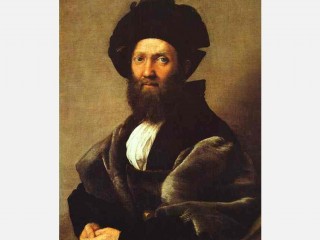
Baldassare Castiglione biography
Date of birth : 1478-12-06
Date of death : 1529-02-02
Birthplace : Casatico, Italy
Nationality : Italian
Category : Famous Figures
Last modified : 2011-01-04
Credited as : Author and courtier, diplomat, Book of the Courtier
The Italian author, courtier, and diplomat Baldassare Castiglione is known primarily for his "Book of the Courtier". This work, which portrays the ideal courtier, was a chief vehicle in spreading Italian humanism into England and France.
Baldassare Castiglione was born on Dec. 6, 1478, in Casatico in the province of Mantua of an illustrious Lombard family. After receiving a classical education in Mantua and in Milan, he served at the court of the Milanese duke Lodovico Sforza from 1496 to 1499. Castiglione then entered the service of Francesco Gonzaga, Duke of Mantua. In 1503 he fought with Gonzaga's forces against the Spanish in Naples. On his way north he visited Rome and Urbino; both cities fascinated him. His request to transfer to the court of Guidobaldo da Montefeltro at Urbino was grudgingly granted in 1504 by Gonzaga.
At Urbino, Guidobaldo's wife, Elizabetta, presided over the noble company depicted in the Libro del cortegiano (Book of the Courtier). Castiglione's service there gave him an entree into the court of Pope Julius II, where he became a friend of the artist Raphael. He was sent as ambassador to Henry VII of England and in 1513 was made Count of Nuvolara by Guidobaldo's successor, Francesco Maria della Rovere. Castiglione married in 1516 but became a cleric in 1521 after the death of his wife. In 1524 he was sent by Pope Clement VII as ambassador to Charles V in Spain— an unfortunate mission in that Castiglione reported wrongly the Emperor's intentions in the period leading up to the sack of Rome in 1527. Castiglione died in Toledo, Spain, on Feb. 7, 1529.
Published in 1528, though it was begun in 1507 and written mainly from 1513 to 1516, Castiglione's Book of the Courtier was a huge and immediate success. His idealized picture of society at the court of Urbino quickly became a book of etiquette for both the bourgeoisie and the aristocracy even beyond the confines of Italy. Translated into
Spanish (1534), French (1537), English (1561), and German (1566), The Courtier saw some 40 editions in the 16th century alone and a hundred more by 1900. Through it, the broad values of Italian humanism—the ideal of the fully developed, well-rounded man, itself the rebirth of a classical ideal—were helped to spread throughout western Europe. Yet it must be admitted that in The Courtier the high qualities of humanitas—culture and virtue—are exalted not for themselves but as tools of self-advancement.
Dignified, melancholy, and idealistic (qualities that Raphael captured in his famous portrait), Castiglione tended not only to soften society's rough edges but also to avoid thorny practical and moral issues. For instance, he says of the Italians' recent poor reputation in arms, "It is better to pass in silence that which cannot be recalled without pain." As to the question of what a courtier should do when ordered by his prince to commit an immoral act such as murder, he states, "There would be too much to say; it must all be left to your discretion." Nevertheless, there is much that is positive in The Courtier; there is a lofty concept of human personality and dignity and of man's creative possibilities.
Castiglione's classical learning is deftly blended into the polite conversation of the courtiers and their ladies. His arguments in favor of literature are derived from those of Cicero in Pro Archia, and his description of the ideal courtier is strongly influenced by Cicero's Deoratore. The courtier should be noble, witty, pleasant, agile, a horseman and a warrior (his principal profession), and devoted to his prince. He should know Greek, Latin, French, and Spanish, and he should be skilled—though not ostentatiously so—in literature, music, painting, and dancing. The courtier's behavior should be characterized by grace and nonchalance (sprezzatura), and he should carefully avoid any affectation. As in Machiavelli and Guicciardini, there is a certain moral relativism: seeming is frequently more important than being.
Only a modest poet in both Italian and Latin, Castiglione wrote a fine sonnet on the ruins of Rome, Superbicolli e voi sacre ruine, which reappears in the Antiquites de Rome of Joachim du Bellay and in Edmund Spenser's Ruines of Rome. His poetry was published in 1760 and his letters in 1769 and 1771.
The most famous translation of The Book of the Courtier is by Sir Thomas Hoby (1561; many later editions); the most recent and readable, by Charles S. Singleton (1959). Castiglione's contribution to the Renaissance is described in Ralph Roeder, The Man of the Renaissance: Four Lawgivers, Savonarola, Machiavelli, Castiglione, Aretino (1933). See also Julia Cartwright, Baldassare Castiglione, the Perfect Courtier: His Life and Letters, 1478-1529 (2 vols., 1908), and Ernest Hatch Wilkins, A History of Italian Literature (1954).
















